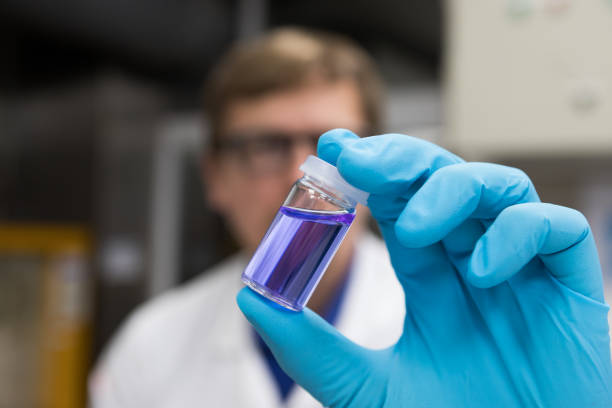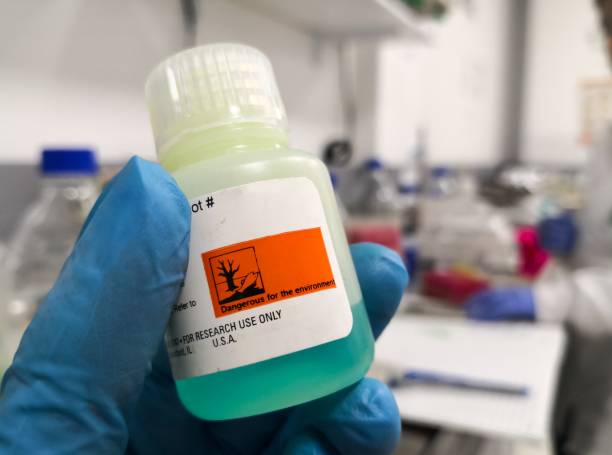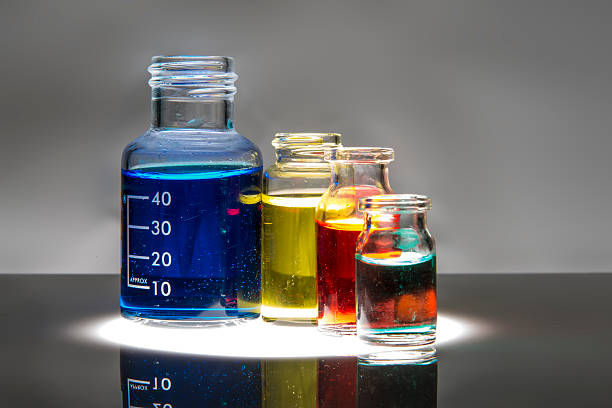Introduction to Bromophenol Blue
Bromophenol blue is a versatile pH indicator dye and laboratory reagent extensively used in biological, chemical, and analytical research. This triphenylmethane dye is valued for its color-changing properties, high sensitivity, and solubility in aqueous solutions. Often appearing as a greenish-blue to purple crystalline powder, bromophenol blue finds relevance in buffer solutions, gel electrophoresis, and acid-base titrations.
Chemical Identity and Structure of Bromophenol Blue
- Chemical Name: 3′,3”,5′,5”-Tetrabromophenolsulfonephthalein
- Molecular Formula: C₁₉H₁₀Br₄O₅S
- Molar Mass: 669.96 g/mol
- Appearance: Blue to purple crystalline powder
- Solubility: Soluble in water, ethanol, and other polar solvents
- CAS Number: 115-39-9
This compound features a sulfonphthalein structure, which is characteristic of many pH indicators. It contains brominated aromatic rings and a sulfonic acid group, contributing to its pH sensitivity and water solubility.
Bromophenol Blue as a pH Indicator

One of the most well-known applications of bromophenol blue is as a pH indicator. Its color changes sharply between pH 3.0 and 4.6:
- Below pH 3.0: Yellow
- Above pH 4.6: Violet to Blue
This transition makes it ideal for identifying the acidic nature of solutions or detecting endpoint transitions in titrations involving weak bases and strong acids.
Buffer System Compatibility
Bromophenol blue is particularly effective in buffered aqueous environments, making it highly reliable for use in protein assays, cell biology, and biotechnology protocols.
Key Applications in Scientific Research
1. Electrophoresis Tracking Dye
One of the most common applications is in gel electrophoresis, where bromophenol blue serves as a tracking dye:
- Electrophoresis of DNA/RNA: It runs ahead of most nucleic acid fragments in agarose or polyacrylamide gels, helping monitor the progress of the experiment.
- Protein Electrophoresis (SDS-PAGE): Included in Laemmli sample buffer, bromophenol blue allows researchers to track protein migration during electrophoresis visually.
This visual cue is crucial for accurate sample management, ensuring no sample loss during migration.
2. Acid-Base Titrations
In analytical chemistry, bromophenol blue is employed as a titration indicator. Its sharp color change is ideal for:
- Determining acidic solutions
- Measuring buffering capacities
- Detecting weak base titration endpoints
Its effectiveness is significantly enhanced in low-concentration solutions, making it suitable for sensitive analytical determinations.
3. Staining in Biological Samples

Bromophenol blue also acts as a stain for biological tissues. It is used in:
- Histology and cytology to highlight protein-rich structures.
- Enhancing microscopic visibility of cellular components.
- Temporary staining during surgical procedures for marking tissues.
This helps distinguish different types of tissues and track procedural accuracy.
Mechanism of Action as a pH Indicator
The indicator works by undergoing structural ionization in response to the concentration of hydrogen ions (H⁺) in the solution. This ionization leads to:
- A shift in conjugation across the molecule.
- Alteration in absorption spectra.
- Visible color change due to changes in electronic configuration.
Its ability to donate and accept protons makes bromophenol blue a reversible pH indicator, which is crucial in repeated-use assays and biochemical environments.
Advantages of Using Bromophenol Blue
- High Sensitivity: Detects minute changes in pH around acidic ranges.
- Color Stability: Retains its distinct color transition over time.
- Low Toxicity: Relatively non-toxic in small quantities used in labs.
- Solubility: Easily dissolves in water and polar solvents.
- Multifunctionality: Works as a dye, stain, and pH indicator.
These attributes make bromophenol blue an essential reagent in academic, clinical, and industrial laboratories.
Storage and Handling Considerations

Bromophenol blue should be handled with care to preserve its effectiveness and ensure safety:
- Protective Measures: Use gloves and safety glasses while handling.
- Disposal: Dispose of according to institutional hazardous waste protocols.
It is important to avoid contamination of stock solutions to maintain experimental accuracy.
Alternative Uses Beyond the Lab
Apart from core laboratory uses, bromophenol blue is also explored in:
- Ink formulations
- Cosmetic industry dyes
- Educational science kits
Its vibrant and pH-sensitive properties are ideal for demonstrations and interactive teaching tools.
Environmental and Safety Aspects
While considered safe at low concentrations, higher exposure can pose minor health risks. Safety data indicates:
- Inhalation or ingestion may cause irritation.
- Not classified as environmentally hazardous, but must be prevented from entering waterways.
- MSDS guidelines recommend standard lab safety practices during use.
Comparison with Other pH Indicators
| Indicator | pH Range | Color Change | Solubility |
|---|---|---|---|
| Bromophenol Blue | 3.0 – 4.6 | Yellow → Blue | High |
| Methyl Orange | 3.1 – 4.4 | Red → Orange-yellow | High |
| Phenolphthalein | 8.2 – 10.0 | Colorless → Pink | Moderate |
| Litmus | 4.5 – 8.3 | Red → Blue | High |
Bromophenol blue is best suited for acidic pH determinations, where other indicators like phenolphthalein are ineffective.
Conclusion: The Essential Role of Bromophenol Blue in Science
Bromophenol blue is more than just a color-changing dye. It is a critical analytical tool across chemistry, biology, and molecular science. From tracking nucleic acids to titration endpoints, its versatility and reliability continue to make it indispensable in both research and academic settings.
Its pH sensitivity, vivid color transition, and compatibility with a wide range of procedures secure its place as a go-to reagent for professionals. Whether you’re conducting a basic classroom experiment or a high-precision biochemical assay, bromophenol blue delivers accuracy, visibility, and consistency.
What is the principle of bromophenol blue?
Introduction to Bromophenol Blue
Bromophenol is a versatile pH indicator dye and laboratory reagent extensively used in biological, chemical, and analytical research. This triphenylmethane dye is valued for its color-changing properties, high sensitivity, and solubility in aqueous solutions. Often appearing as a greenish-blue to purple crystalline powder, bromophenol finds relevance in buffer solutions, gel electrophoresis, and acid-base titrations.
Chemical Identity and Structure of Bromophenol
Chemical Name: 3′,3”,5′,5”-Tetrabromophenolsulfonephthalein
Molecular Formula: C₁₉H₁₀Br₄O₅S
Molar Mass: 669.96 g/mol
Appearance: Blue to purple crystalline powder
Solubility: Soluble in water, ethanol, and other polar solvents
CAS Number: 115-39-9
This compound features a sulfonphthalein structure, which is characteristic of many pH indicators. It contains brominated aromatic rings and a sulfonic acid group, contributing to its pH sensitivity and water solubility.
Bromophenol Blue as a pH Indicator
One of the most well-known applications of bromophenol blue is as a pH indicator. Its color changes sharply between pH 3.0 and 4.6:
Below pH 3.0: Yellow
Above pH 4.6: Violet to Blue
This transition makes it ideal for identifying the acidic nature of solutions or detecting endpoint transitions in titrations involving weak bases and strong acids.
Buffer System Compatibility
Bromophenol is particularly effective in buffered aqueous environments, making it highly reliable for use in protein assays, cell biology, and biotechnology protocols.
Key Applications in Scientific Research
1. Electrophoresis Tracking Dye
One of the most common applications is in gel electrophoresis, where bromophenol blue serves as a tracking dye:
Electrophoresis of DNA/RNA: It runs ahead of most nucleic acid fragments in agarose or polyacrylamide gels, helping monitor the progress of the experiment.
Protein Electrophoresis (SDS-PAGE): Included in Laemmli sample buffer, bromophenol blue allows researchers to track protein migration during electrophoresis visually.
This visual cue is crucial for accurate sample management, ensuring no sample loss during migration.
2. Acid-Base Titrations
In analytical chemistry, bromophenol is employed as a titration indicator. Its sharp color change is ideal for:
Determining acidic solutions
Measuring buffering capacities
Detecting weak base titration endpoints
Its effectiveness is significantly enhanced in low-concentration solutions, making it suitable for sensitive analytical determinations.
3. Staining in Biological Samples
Bromophenol blue also acts as a stain for biological tissues. It is used in:
Histology and cytology to highlight protein-rich structures.
Enhancing microscopic visibility of cellular components.
Temporary staining during surgical procedures for marking tissues.
This helps distinguish different types of tissues and track procedural accuracy.
Mechanism of Action as a pH Indicator
The indicator works by undergoing structural ionization in response to the concentration of hydrogen ions (H⁺) in the solution. This ionization leads to:
A shift in conjugation across the molecule.
Alteration in absorption spectra.
Visible color change due to changes in electronic configuration.
Its ability to donate and accept protons makes bromophenol blue a reversible pH indicator, which is crucial in repeated-use assays and biochemical environments.
Advantages of Using Bromophenol Blue
High Sensitivity: Detects minute changes in pH around acidic ranges.
Color Stability: Retains its distinct color transition over time.
Low Toxicity: Relatively non-toxic in small quantities used in labs.
Solubility: Easily dissolves in water and polar solvents.
Multifunctionality: Works as a dye, stain, and pH indicator.
These attributes make bromophenol blue an essential reagent in academic, clinical, and industrial laboratories.
Storage and Handling Considerations
Bromophenol blue should be handled with care to preserve its effectiveness and ensure safety:
Protective Measures: Use gloves and safety glasses while handling.
Disposal: Dispose of according to institutional hazardous waste protocols.
It is important to avoid contamination of stock solutions to maintain experimental accuracy.
Alternative Uses Beyond the Lab
Apart from core laboratory uses, bromophenol blue is also explored in:
Ink formulations
Cosmetic industry dyes
Educational science kits
Its vibrant and pH-sensitive properties are ideal for demonstrations and interactive teaching tools.
Environmental and Safety Aspects
While considered safe at low concentrations, higher exposure can pose minor health risks. Safety data indicates:
Inhalation or ingestion may cause irritation.
Not classified as environmentally hazardous, but must be prevented from entering waterways.
MSDS guidelines recommend standard lab safety practices during use.
Comparison with Other pH Indicators
| Indicator | pH Range | Color Change | Solubility |
|---|---|---|---|
| Bromophenol Blue | 3.0 – 4.6 | Yellow → Blue | High |
| Methyl Orange | 3.1 – 4.4 | Red → Orange-yellow | High |
| Phenolphthalein | 8.2 – 10.0 | Colorless → Pink | Moderate |
| Litmus | 4.5 – 8.3 | Red → Blue | High |
Conclusion: The Essential Role of Bromophenol Blue in Science
Bromophenol blue is more than just a color-changing dye. It is a critical analytical tool across chemistry, biology, and molecular science. From tracking nucleic acids to titration endpoints, its versatility and reliability continue to make it indispensable in both research and academic settings.
Its pH sensitivity, vivid color transition, and compatibility with a wide range of procedures secure its place as a go-to reagent for professionals. Whether you’re conducting a basic classroom experiment or a high-precision biochemical assay, bromophenol blue delivers accuracy, visibility, and consistency.
What are the applications of Bromophenol Blue indicator?
1. Electrophoresis Tracking Dye
One of the most common applications is in gel electrophoresis, where bromophenol blue serves as a tracking dye:
Electrophoresis of DNA/RNA: It runs ahead of most nucleic acid fragments in agarose or polyacrylamide gels, helping monitor the progress of the experiment.
Protein Electrophoresis (SDS-PAGE): Included in Laemmli sample buffer, bromophenol blue allows researchers to track protein migration during electrophoresis visually.
This visual cue is crucial for accurate sample management, ensuring no sample loss during migration.
2. Acid-Base Titrations
In analytical chemistry, bromophenol blue is employed as a titration indicator. Its sharp color change is ideal for:
Determining acidic solutions
Measuring buffering capacities
Detecting weak base titration endpoints
Its effectiveness is significantly enhanced in low-concentration solutions, making it suitable for sensitive analytical determinations.
3. Staining in Biological Samples
Bromophenol blue also acts as a stain for biological tissues. It is used in:
Histology and cytology to highlight protein-rich structures.
Enhancing microscopic visibility of cellular components.
Temporary staining during surgical procedures for marking tissues.
This helps distinguish different types of tissues and track procedural accuracy.
Why is bromophenol blue used?
Introduction to Bromophenol Blue
Bromophenol blue is a versatile pH indicator dye and laboratory reagent extensively used in biological, chemical, and analytical research. This triphenylmethane dye is valued for its color-changing properties, high sensitivity, and solubility in aqueous solutions. Often appearing as a greenish-blue to purple crystalline powder, bromophenol blue finds relevance in buffer solutions, gel electrophoresis, and acid-base titrations.
Chemical Identity and Structure of Bromophenol Blue
Chemical Name: 3′,3”,5′,5”-Tetrabromophenolsulfonephthalein
Molecular Formula: C₁₉H₁₀Br₄O₅S
Molar Mass: 669.96 g/mol
Appearance: Blue to purple crystalline powder
Solubility: Soluble in water, ethanol, and other polar solvents
CAS Number: 115-39-9
This compound features a sulfonphthalein structure, which is characteristic of many pH indicators. It contains brominated aromatic rings and a sulfonic acid group, contributing to its pH sensitivity and water solubility.
Bromophenol Blue as a pH Indicator
One of the most well-known applications of bromophenol blue is as a pH indicator. Its color changes sharply between pH 3.0 and 4.6:
Below pH 3.0: Yellow
Above pH 4.6: Violet to Blue
This transition makes it ideal for identifying the acidic nature of solutions or detecting endpoint transitions in titrations involving weak bases and strong acids.
Buffer System Compatibility
Bromophenol blue is particularly effective in buffered aqueous environments, making it highly reliable for use in protein assays, cell biology, and biotechnology protocols.
Key Applications in Scientific Research
1. Electrophoresis Tracking Dye
One of the most common applications is in gel electrophoresis, where bromophenol blue serves as a tracking dye:
Electrophoresis of DNA/RNA: It runs ahead of most nucleic acid fragments in agarose or polyacrylamide gels, helping monitor the progress of the experiment.
Protein Electrophoresis (SDS-PAGE): Included in Laemmli sample buffer, bromophenol blue allows researchers to track protein migration during electrophoresis visually.
This visual cue is crucial for accurate sample management, ensuring no sample loss during migration.
2. Acid-Base Titrations
In analytical chemistry, bromophenol blue is employed as a titration indicator. Its sharp color change is ideal for:
Determining acidic solutions
Measuring buffering capacities
Detecting weak base titration endpoints
Its effectiveness is significantly enhanced in low-concentration solutions, making it suitable for sensitive analytical determinations.
3. Staining in Biological Samples
Bromophenol blue also acts as a stain for biological tissues. It is used in:
Histology and cytology to highlight protein-rich structures.
Enhancing microscopic visibility of cellular components.
Temporary staining during surgical procedures for marking tissues.
This helps distinguish different types of tissues and track procedural accuracy.
Mechanism of Action as a pH Indicator
The indicator works by undergoing structural ionization in response to the concentration of hydrogen ions (H⁺) in the solution. This ionization leads to:
A shift in conjugation across the molecule.
Alteration in absorption spectra.
Visible color change due to changes in electronic configuration.
Its ability to donate and accept protons makes bromophenol blue a reversible pH indicator, which is crucial in repeated-use assays and biochemical environments.
Advantages of Using Bromophenol Blue
High Sensitivity: Detects minute changes in pH around acidic ranges.
Color Stability: Retains its distinct color transition over time.
Low Toxicity: Relatively non-toxic in small quantities used in labs.
Solubility: Easily dissolves in water and polar solvents.
Multifunctionality: Works as a dye, stain, and pH indicator.
These attributes make bromophenol blue an essential reagent in academic, clinical, and industrial laboratories.
Storage and Handling Considerations
Bromophenol blue should be handled with care to preserve its effectiveness and ensure safety:
Protective Measures: Use gloves and safety glasses while handling.
Disposal: Dispose of according to institutional hazardous waste protocols.
It is important to avoid contamination of stock solutions to maintain experimental accuracy.
Alternative Uses Beyond the Lab
Apart from core laboratory uses, bromophenol blue is also explored in:
Ink formulations
Cosmetic industry dyes
Educational science kits
Its vibrant and pH-sensitive properties are ideal for demonstrations and interactive teaching tools.
Environmental and Safety Aspects
While considered safe at low concentrations, higher exposure can pose minor health risks. Safety data indicates:
Inhalation or ingestion may cause irritation.
Not classified as environmentally hazardous, but must be prevented from entering waterways.
MSDS guidelines recommend standard lab safety practices during use.
Comparison with Other pH Indicators
| Indicator | pH Range | Color Change | Solubility |
|---|---|---|---|
| Bromophenol Blue | 3.0 – 4.6 | Yellow → Blue | High |
| Methyl Orange | 3.1 – 4.4 | Red → Orange-yellow | High |
| Phenolphthalein | 8.2 – 10.0 | Colorless → Pink | Moderate |
| Litmus | 4.5 – 8.3 | Red → Blue | High |
Conclusion: The Essential Role of Bromophenol Blue in Science
Bromophenol blue is more than just a color-changing dye. It is a critical analytical tool across chemistry, biology, and molecular science. From tracking nucleic acids to titration endpoints, its versatility and reliability continue to make it indispensable in both research and academic settings.
Its pH sensitivity, vivid color transition, and compatibility with a wide range of procedures secure its place as a go-to reagent for professionals. Whether you’re conducting a basic classroom experiment or a high-precision biochemical assay, bromophenol blue delivers accuracy, visibility, and consistency.
What are the advantages of Bromophenol Blue indicator?
High Sensitivity: Detects minute changes in pH around acidic ranges.
Color Stability: Retains its distinct color transition over time.
Low Toxicity: Relatively non-toxic in small quantities used in labs.
Solubility: Easily dissolves in water and polar solvents.
Multifunctionality: Works as a dye, stain, and pH indicator.
These attributes make bromophenol blue an essential reagent in academic, clinical, and industrial laboratories.
